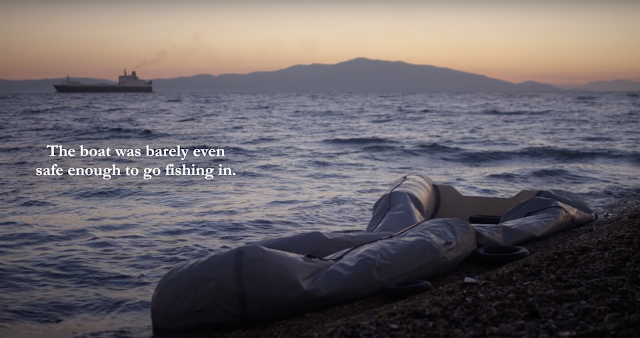Documentary - Analysis of a relevant documentary
During the process of creating our documentary, I watched "Refuge" (The Atlantic, 2016). A film that delves into the plight of Syrian refugees who have made their way to Greece. The film is shot on location, with refugees recounting the events that led them to escape. Stylistically, it mixes a ‘talking heads’ format, with interspersals of observational footage, which effectively emphasises emotional and contextual drama; we see ruined areas of Syria, Refugees huddling together in camps and dinghies washed ashore.
 |
| An example of the text overlay in Refuge (The Atlantic, 2016) |
The documentary also uses a text overlay (As above) which I was incredibly fond of. The use of text is not only functional to subtitle Refugees’ speech, but also stylistically effective. The typeface is subtle and reminiscent of print work, giving the documentary a feeling of being a medley of visual and traditional written storytelling; it feels as though a book has been brought to life.
The content in this documentary is simplistic in some ways, but because of the themes explored, it is also incredibly powerful and moving. Knowing that the Documentary that the group and I intend to make shares many of the same themes, this was a good opportunity as Director to try and develop my own visual style to best tell the narrative from our contributors. The shallow depth of field used In ‘Refuge’ is very successful in directing the viewer to digest only the necessary information in the frame and focus on the contributor in front of the camera; having visual stimuli elsewhere in the frame might have been distracting and as a result; far less emotionally impactful.
 |
| An example of the shallow depth of field used in Refuge (The Atlantic, 2016) |
This intimate style also adds to a feeling of being immersed in the space, minimising the space between the viewer and those on-screen. I was reminded of another fantastic example of this kind of viewing, the excellent "Garage People" (Garage People/Garagenvolk, 2020) which employs the position of a fly on the wall and fully immerses you in the environment in a visually and technically impressive way that I’d like to recreate in my own work.
 |
| A still from Garage People (Garage People/Garagenvolk, 2020) |
In "Documentary and Collaboration: Placing the Camera in the Community" (Coffman, 2009), Elizabeth Coffman speaks to a member of her alumni who is also practised in social work,
"I think documentary video workers could benefit from some aspects of social work.The first thing that comes to mind is basics of building rapport, developing empathy, using interview techniques. Then, having some psychological background in understanding why people act or respond the way they do."
Going into the production and shooting of our Documentary, I was conscious about getting my approach right with my contributors. I wanted to be sure that I was friendly and open, while also remaining formal and boundaried; a difficult balance. As somebody with social care experience, I could relate to the quote above and apply my knowledge of working with a broad spectrum of people to tailor my approach, it’s important to be able to read a room and acknowledge that different techniques or even personal characteristics will all have implications on the way that the contributor will perceive you. I knew that the quality of the interview would be reliant on the connection I made with the contributors. This quality is evident in Refuge, where the contributors are open to expressing their deepest fears and most traumatic experiences. Unfortunately, I was unable to find any research into the creative process of Refuge, but I would safely assume that the crew spent much of their time on location in Greece, getting to know the refugees who were living there on a personal level. It is also worth noting that for some, speaking about trauma can be therapeutic and that your presence and listening, is of tremendous benefit to them as well as you, a profitable mutual exchange for both parties.
I enjoyed Refuge for its ability to truly connect with its contributors and presenting their stories plainly, but emotionally. It was also often beautiful at times, the shot of the dinghy above is incredibly poignant and symbolic of the struggles that many of the refugees will experience. It presents a fantastic contrast in beautifying something that is also a the most shallow depths of human despair which is visually impactful. I’d like to create these striking moments of contrast within our documentary to really drive home the importance of our narrative in a way that connects with viewers.
Bibliography:
Coffman, E., 2009. Documentary and Collaboration: Placing the Camera in the Community. 61st ed. Chicago, p.75.
The Atlantic, 2016. Refuge. [video] Available at: <https://www.youtube.com/watch?v=6b5H7je4m1A> [Accessed 1 May 2022].
Garage People/Garagenvolk. 2020. [film] Directed by N. Yefimkina. Russia: ARTE.

Comments
Post a Comment